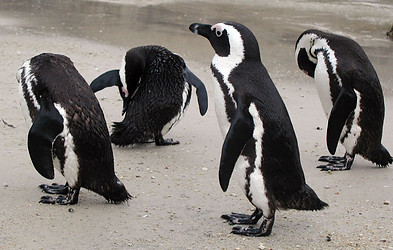Sphenisciformes



This tree diagram shows the relationships between several groups of organisms.
The root of the current tree connects the organisms featured in this tree to their containing group and the rest of the Tree of Life. The basal branching point in the tree represents the ancestor of the other groups in the tree. This ancestor diversified over time into several descendent subgroups, which are represented as internal nodes and terminal taxa to the right.

You can click on the root to travel down the Tree of Life all the way to the root of all Life, and you can click on the names of descendent subgroups to travel up the Tree of Life all the way to individual species.
For more information on ToL tree formatting, please see Interpreting the Tree or Classification. To learn more about phylogenetic trees, please visit our Phylogenetic Biology pages.
close boxReferences
Bertelli, S., and N. P. Giannini. 2005. A phylogeny of extant penguins (Aves: Sphenisciformes) combining morphology and mitochondrial sequences. Cladistics 21: 209-239.
Giannini, N. P., and S. Bertelli. 2004. Phylogeny of extant penguins based on integumentary and breeding characters. The Auk 121: 422-434.
Grant, W. S., D. C. Duffy, and R. W. Leslie. 1994. Allozyme phylogeny of Spheniscus penguins. The Auk 111: 716-270.
Müller-Schwarze, D. 1984. The behavior of penguins: adapted to ice and tropics. State University of New York Press, Albany.
O’Hara, R. J. 1989. An estimate of the phylogeny of the living penguins (Aves: Spheniscidae). Am. Zool. 29, 11A.
Simpson, G. G. 1946. Fossil Penguins. Bull. Am. Mus. Nat. Hist. 87, 1–100.
Simpson, G. G. 1972. Conspectus of Patagonian fossil penguins. Am. Mus. Nov. 2488, 1–37.
Simpson, G. G. 1976. Penguins: past and present, here and there. Yale University Press, New Haven.
Stonehouse, B. 1975. The biology of penguins. University Park Press, Baltimore.
Williams, T. D. 1995. The Penguins. Oxford University Press, New York.
Zusi, R. L. 1975. An interpretation of skull structure in penguins. In: Stonehouse, B. (Ed.), The Biology of Penguins. University Park Press, Baltimore, MD, pp. 59–84.
Title Illustrations
| Scientific Name | Spheniscus demersus |
|---|---|
| Location | near Simonstown, South Africa |
| Comments | African (Jackass) penguins |
| Acknowledgements | Photograph courtesy InsectImages.org (#1125022) |
| Specimen Condition | Live Specimen |
| Copyright | © Paul Bolstad, University of Minnesota |







